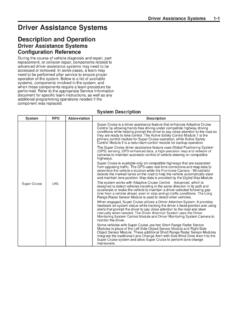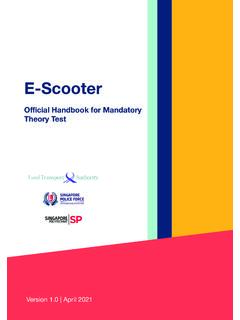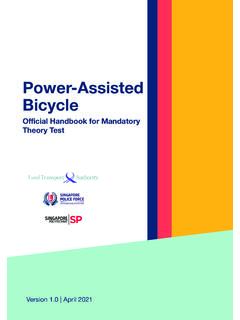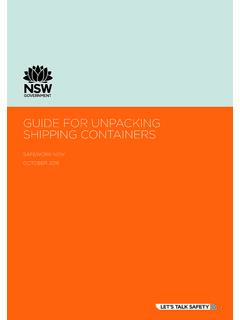Transcription of Subject: Wheel Alignment Specifications, Requirements and ...
1 Document ID: 4281815 #05-03-07-009H: Wheel Alignment Specifications, Requirements and Recommendations for GM Vehicles - (Oct 2, 2015) Subject: Wheel Alignment Specifications, Requirements and Recommendations for GM Vehicles Models: 2016 and Prior GM Passenger Cars and Light Duty Trucks This Bulletin has been revised to update information in the Wheel Alignment Job Card Questionnaire and remove sections Mileage Policy and Warranty Documentation Requirements . Please discard Corporate Bulletin Number 05-03-07-009G. Purpose The purpose of this bulletin is to provide retail, wholesale and fleet personnel with General Motors recommendations for customer concerns related to Wheel Alignment . For your convenience, this bulletin updates and centralizes all of GM's Standard Wheel Alignment Service Procedures, and bulletins on Wheel Alignment warranty service.
2 Important: PLEASE FAMILIARIZE YOURSELF WITH THESE UPDATES BEFORE PERFORMING YOUR NEXT GM Wheel Alignment SERVICE. The following key steps are a summary of this bulletin and are REQUIRED in completing a successful Wheel Alignment service. 1. Verify the vehicle is in an Original Equipment condition for curb weight, tires, wheels, suspension and steering configurations. Vehicles modified in any of these areas are not covered for Wheel Alignment warranty. 2. Review the customer concern relative to Normal Operation definitions. 3. Document Wheel Alignment warranty claims appropriately for labor operations 8070012 and 8070032. A copy of the Alignment machine printout showing before and after Alignment specifications must be attached to the job card.
3 Please refer to Article ( Canada) of the Service Policies and Procedures for complete documentation Requirements and labor operation restrictions for transactions involving Wheel alignments, toe adjustments and Wheel balancing. Verify Original Equipment Condition of the Vehicle Verify that Original Equipment Tires and Wheels or Official GM Accessory Tires and Wheels are on the vehicle. Verify that aftermarket suspension Lift or Lowering Kits or other suspension alterations have NOT been done to the vehicle. Check for accidental damage to the vehicle; for example, severe pothole or curb impacts, collision damage that may have affected the Wheel Alignment of the vehicle; , engine cradles, suspension control arms, axles, wheels, Wheel covers, tires may show evidence of damage/impact.
4 Check to be sure vehicle has seen Normal Use rather than abuse; , very aggressive driving may show up by looking at the tires and condition of the vehicle. Check for other additional equipment items that may significantly affect vehicle mass such as large tool boxes, campers, snow plow packages (without the snowplow RPO), etc., especially in trucks and cutaway/incomplete vehicles. Significant additional mass can affect trim height and Wheel Alignment of the vehicle and may necessitate a customer pay Wheel Alignment when placed semi-permanently in the vehicle (Upfitter instructions are to realign the vehicle after placement of these types of items. (This typically applies to trucks and incomplete vehicles that can be upfit with equipment such as the above.))
5 Customer Concerns and Normal Operation Conditions Possible Concerns The following are typical conditions that may require Wheel Alignment warranty service: 1. Lead/Pull: defined as "at a constant highway speed on a typical straight road, the amount of effort required at the steering Wheel to maintain the vehicle s straight heading." Important: Please evaluate for the condition with hands-on the steering Wheel . Follow the Vehicle Leads/Pulls diagnostic tree located in SI to determine the cause of a lead/pull concern. Lead/Pull concerns can be due to road crown or road slope, tires, Wheel Alignment or even in rare circumstances a steering gear issue. Lead/pull concerns due to road crown are considered Normal Operation and are NOT a warrantable condition -- the customer should be advised that this is Normal Operation.
6 Important: Some customers may comment on a Lead/Pull when they hold the steering Wheel in a level condition. If so, this is more likely a steering Wheel angle concern because the customer is steering the vehicle to obtain a level steering Wheel . 2. Steering Wheel angle to the left or right (counter-clockwise or clockwise, respectively): Defined as the steering Wheel angle (clocking) deviation from level while maintaining a straight heading on a typical straight road. 3. Irregular or Premature tire wear: Slight to very slight "feathering" or "edge" wear on the shoulders of tires is NOT considered unusual and should even out with a tire rotation; if the customer is concerned about a feathering condition of the tires, the customer could be advised to rotate the tires earlier than the next scheduled mileage/maintenance interval (but no later than the next interval).
7 Be sure to understand the customer s driving habits as this will also heavily influence the tire wear performance; tire wear from aggressive or abusive driving habits is NOT a warrantable condition. Important: Slight or mild feathering, cupping, edge or heel/toe wear of tire tread shoulders is normal and can show up very early in a tire/vehicle service mileage; in fact, some new tires can show evidence of feathering from the factory. These issues do NOT affect the overall performance and tread life of the tire. Dealer personnel should always check the customer s maintenance records to ensure that tire inflation pressure is being maintained to placard and that the tires are being rotated (modified-X pattern) at the proper mileage intervals.
8 Wheel alignments are NOT to be performed for the types of Normal Tire Feathering shown in Figures 1-4 below. Figure 1: Full Tread View NORMAL Tire Feathering Wear on the Shoulder/Adjacent/Center Ribs Figure 2: Tire Shoulder View Example 1 - NORMAL Tire "Feathering" Wear on the Shoulder Figure 3: Tire Shoulder View Example 2 - NORMAL Tire "Feathering" Wear Figure 4: Detail Side View of Tire Shoulder Area - NORMAL Tire Feathering Wear Important: When a Wheel Alignment is deemed necessary for tire wear, be sure to document on the repair order, in as much detail as possible, the severity and type of tire wear ( , severe center wear or severe inside or outside shoulder wear) and the position of the tire on the vehicle (RF, LF, LR, RR).
9 Please note the customer s concern with the wear such as, noise, appearance, wear life, etc. A field product report with pictures of the tire wear condition is recommended. Refer to the latest version of Corporate Bulletin Numbers 02-00-89-002 (Canada, 10-00-89-006) and 07-00-89-036. 4. Other repairs that affect Wheel Alignment ; , certain component replacement such as suspension control arm replacement, engine cradle adjustment/replace, steering gear replacement, steering tie rod replace, suspension strut/shock, steering knuckle, etc. may require a Wheel Alignment . Important: If other components or repairs are identified as affecting the Wheel Alignment , policy calls for the Wheel Alignment labor time to be charged to the replaced/repaired component s labor operation time rather than the Wheel Alignment labor operations.
10 Important: Vibration type customer concerns are generally NOT due to Wheel Alignment except in the rare cases; , extreme diagonal wear across the tread. In general, Wheel alignments are NOT to be performed as an investigation/correction for vibration concerns. Normal Operation Conditions Vehicle Lead/Pull Due to Road Crown or Slope: As part of Normal Operation, vehicles will follow side-to-side or left to right road crown or slope. Be sure to verify from the customer the types of roads they are driving as they may not recognize the influence of road crown on vehicle lead/pull and steering Wheel angle. If a vehicle requires significant steering effort to prevent it from climbing the road crown there may be an issue to be looked into further.










